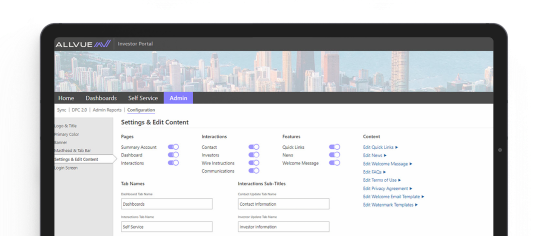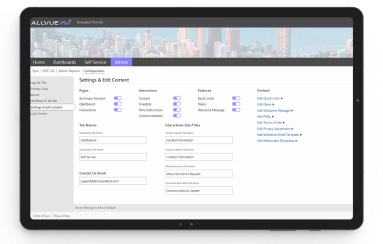
By: Laura Sankowich
Allvue Marketing Thought Leadership and PR
April 23, 2025
In the private equity landscape, fund managers are tasked with optimizing portfolios to maximize returns while both managing risk and ensuring alignment with investors’ goals. Needless to say, this balancing act can be both complex and time-consuming.
Model portfolios provide an easy way to navigate this complexity by offering pre-built, structured approaches to investing.
In this article, we’ll break down how model portfolios work in private equity and the strategic advantages they offer. We’ll also look at how technological solutions like Allvue’s Portfolio Monitoring Software can help you maximize the value of model portfolios and unlock even more success for your firm.
How do model portfolios work in private equity?
Model portfolios in private equity are structured templates that are designed to guide asset allocation across a variety of investment strategies (such as venture capital, growth equity, and buyouts), industries, geographical regions, and so on.
These templates offer private equity fund managers and investors a ready-made investment framework that’s tailored to specific risk and return objectives. The framework allows them to efficiently deploy capital without needing to develop an investment strategy from scratch.
Key characteristics of model portfolios in private equity
Model portfolios have several key defining features.
- Diversification: Model portfolios are designed to achieve diversification by spreading investments across multiple strategies, geographies, and industries. Diversification helps reduce the impact of any single investment’s underperformance on the overall portfolio.
- Risk management: Model portfolios integrate risk management techniques to balance potential returns with the investor’s risk tolerance. That involves assessing and controlling various types of risk, including market risk, operational risk, and liquidity risk.
- Performance objectives: Model portfolios are designed to achieve specific performance objectives, such as a target internal rate of return (IRR) or a certain level of capital appreciation. These objectives guide asset allocation.
- Customization: While model portfolios follow a generally standardized structure, most can be customized to meet the unique needs of each investor. For example, they can be customized based on an investor’s risk tolerance, investment time horizon, and liquidity preferences.
- Transparency: Model portfolios offer great transparency. They provide investors with clear information about the portfolio’s composition as well as regular updates on the portfolio’s performance and risk exposure.
Key benefits of model portfolios
Private equity model portfolios deliver a wide range of benefits to private equity firms and investors.
Simplified decision-making
Model portfolios in private equity streamline the portfolio construction process by eliminating the need to select individual assets. Instead, investors follow proven, standardized allocation templates. This enhances overall operational efficiency and reduces decision-making complexity.
Faster capital deployment
Pre-designed allocation templates within model portfolios expedite the investment process, significantly reducing the time required to evaluate and deploy capital. This ensures that firms can promptly seize emerging opportunities, which in turn can help them maintain a competitive edge in the market.
Professional expertise
Model portfolios are often crafted with input from leading industry analysts, researchers, investment committees, and experts. This allows investors to benefit and potentially profit from the expertise of these professionals.
Scalability across funds
Model portfolios provide a scalable framework that can be replicated or adapted. This standardization is particularly valuable for firms managing large volumes of assets across diverse markets.
Increased investor confidence
For private equity firms, offering model portfolios can increase investor confidence by demonstrating a data-driven, systematic approach to asset management. These portfolios are often built with transparency in mind as we saw. They offer investors a clear view of the underlying investment strategies, asset allocations, and risk metrics. Such clarity fosters investor trust and encourages continued investment.
Cost savings
A key benefit of model portfolios is their ability to drive cost savings across various aspects of portfolio development and management. For example, using pre-constructed portfolios reduces the costs associated with bespoke portfolio development. Additionally, the economies of scale achieved through model portfolios allow firms to manage multiple client portfolios without a proportional increase in operational expenses.
Minimized investment bias
Subjective decision-making is a common issue in the private equity investment space. Using a structured framework can help avoid that and ensure a data-driven, unbiased approach to investment selection and asset allocation.
Enhanced compliance
Model portfolios enhance compliance by embedding rules and guidelines directly into the portfolio structure. This can allow PE firms and investors to avoid penalties and fines related to non-compliance.
How Allvue helps firms maximize the potential of model portfolios in private equity
Allvue Systems provides private equity firms and investors with advanced tools and capabilities to help extract even greater value from their model portfolios including the following.
Real-time monitoring
Allvue’s platform offers real-time portfolio monitoring, enabling firms to track portfolio behavior as market conditions change. With immediate access to performance metrics and risk exposure data, for example, firms can make timely adjustments to ensure portfolios stay aligned with their objectives.
Simplified compliance management
Regulatory landscapes in private equity are complex and ever-changing. Allvue simplifies compliance by automating the tracking and reporting of regulatory requirements. The platform ensures that model portfolios remain compliant with jurisdictional mandates. This reduces legal risks and ensures peace of mind for both firms and their investors.
Customized reporting for transparency
A key component of model portfolio success is transparent reporting to stakeholders. Allvue provides customizable reporting features that enable private equity firms to efficiently deliver a wide range of important info like portfolio performance, risk exposure, and alignment with investment strategies. This transparency fosters stronger relationships with investors and builds trust.
Seamless integration with existing workflows
Allvue’s platform integrates smoothly with other private equity operations or workflows, such as pipeline and deal management, and fundraising. This integration ensures that model portfolios are part of a cohesive, end-to-end solution that supports broader business objectives.
The future of model portfolios in private equity
As private equity continues to evolve, model portfolios are expected to undergo significant transformations, driven by advancements in technology.
Artificial Intelligence (AI), in particular, is expected to play a major role in revolutionizing model portfolios in the coming years. For example, AI can analyze vast amounts of data faster and provide more accurate predictions or insights about asset performance, risk factors, and market trends than traditional methods. Meanwhile, machine learning algorithms can continuously refine model portfolios by continuously learning from new data.
These technologies pave the way for highly advanced model portfolios that align even more closely with investor objectives and risk tolerance, and that therefore deliver even better outcomes.
Another key trend in the future of model portfolios is greater personalization. While today’s model portfolios allow some customization — such as adjusting for risk appetite, industry interests, and geographic preferences — the future will see even more granular personalization. Firms will have the ability to tailor portfolios based on a deeper understanding of each investor’s unique characteristics.
Wrapping up
A model portfolio in private equity is a curated collection of diversified investments designed to achieve specific financial goals within a corresponding risk profile. It serves as a blueprint for investors, providing a structured approach to asset allocation.
Leveraging model portfolios delivers several benefits to private equity firms and investors including streamlined decision-making, faster capital deployment, reduced operational costs, more scalability, and enhanced compliance.
Allvue’s Portfolio Monitoring Software—through features like real-time monitoring, customizable reporting, and seamless integration with existing workflows—can help you unlock more value from model portfolios and achieve better outcomes for your investors.
Request a free demo today to see Allvue’s cutting-edge solutions in action.
Source
Marcum. How Artificial Intelligence is Revolutionizing Private Equity and Hedge Funds. https://www.marcumllp.com/insights/how-artificial-intelligence-is-revolutionizing-private-equity-and-hedge-funds
More About The Author

Laura Sankowich
Allvue Marketing Thought Leadership and PR
An expert in digital strategy, content marketing, PR, and thought leadership, Laura brings more than 20 years of B2B marketing and communications experience to Allvue. Laura has extensive experience working for both publicly and privately held Fintech firms.


